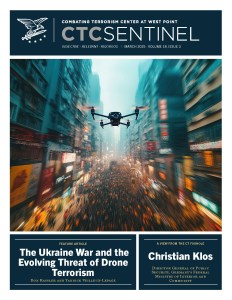From the Editor
The March issue focuses in particular on the drone threat. In the feature article, Don Rassler and Yannick Veilleux-Lepage examine the evolution of terrorist drone usage and forecast its future trajectory in light of the tactical and technological innovations emerging from the Russo-Ukrainian War. They write that “the conflict has become a critical ‘innovation hub’ for drone warfare, accelerating advancements in the scale, speed, and range of drone operations. These developments are not only transforming the modern battlefield but also creating new opportunities for violent extremist organizations (VEOs) to enhance their operational capabilities.” They assess that “in particular, the war has normalized large-scale drone deployment, demonstrating the feasibility of launching coordinated drone swarms and phased attacks capable of overwhelming existing defenses” and note that the potential future pairing of high-speed First-Person View (FPV) drones with emerging technologies such as AI-assisted targeting “could significantly increase the precision and impact of future attacks.” In a similar vein, Jake Dulligan, Laura Freeman, Austin Phoenix, and Bradley Davis, in assessing the threat posed by commercial drones, write that the biggest concern “is that drone swarms could dramatically increase the impact of bad actor drone operations, be it kinetic strikes, ISR, or psychological warfare.”
This month’s interview is with Dr. Christian Klos, the Director General of Public Security at Germany’s Federal Ministry of Interior and Community. He says that “when it comes to the external threat, I would agree with the assessment that ISIS-K is in Germany as well. What we observe from the intelligence side is that there are clear indications that the group intends to conduct attacks in Europe, and this can also include Germany and therefore we are very much aware of this threat, and we have seen also travel activities. So, it’s not just some minor indications.”
Aaron Zelin assesses the new Syrian government’s efforts to counter the Islamic State, Hezbollah, and the captagon trade. He writes: “Unlike the Assad regime—which did little to fight the Islamic State, was closely aligned with Hezbollah, and produced captagon on an industrial scale—HTS in its guise as the new government of Syria is taking on these challenges assertively, and has a significant track record in doing so previously. Not only are these efforts a benefit to Syrian society and the security and stability of the country, but they also align with the interests of the United States and U.S. regional allies.”
Alexandre Rodde and Justin Olmstead examine the evolution of vehicular ramming attacks and prevention efforts. They write that “when it comes to indicators and warnings of future attacks, the demonstration effect created by high-casualty vehicle-ramming attacks has in the past seemingly produced a surge in copycat attacks, which means the security agencies should be particularly vigilant given the recent uptick in high-profile attacks, including the New Orleans attack.”
Paul Cruickshank, Editor-in-Chief
 Skip to content
Skip to content

